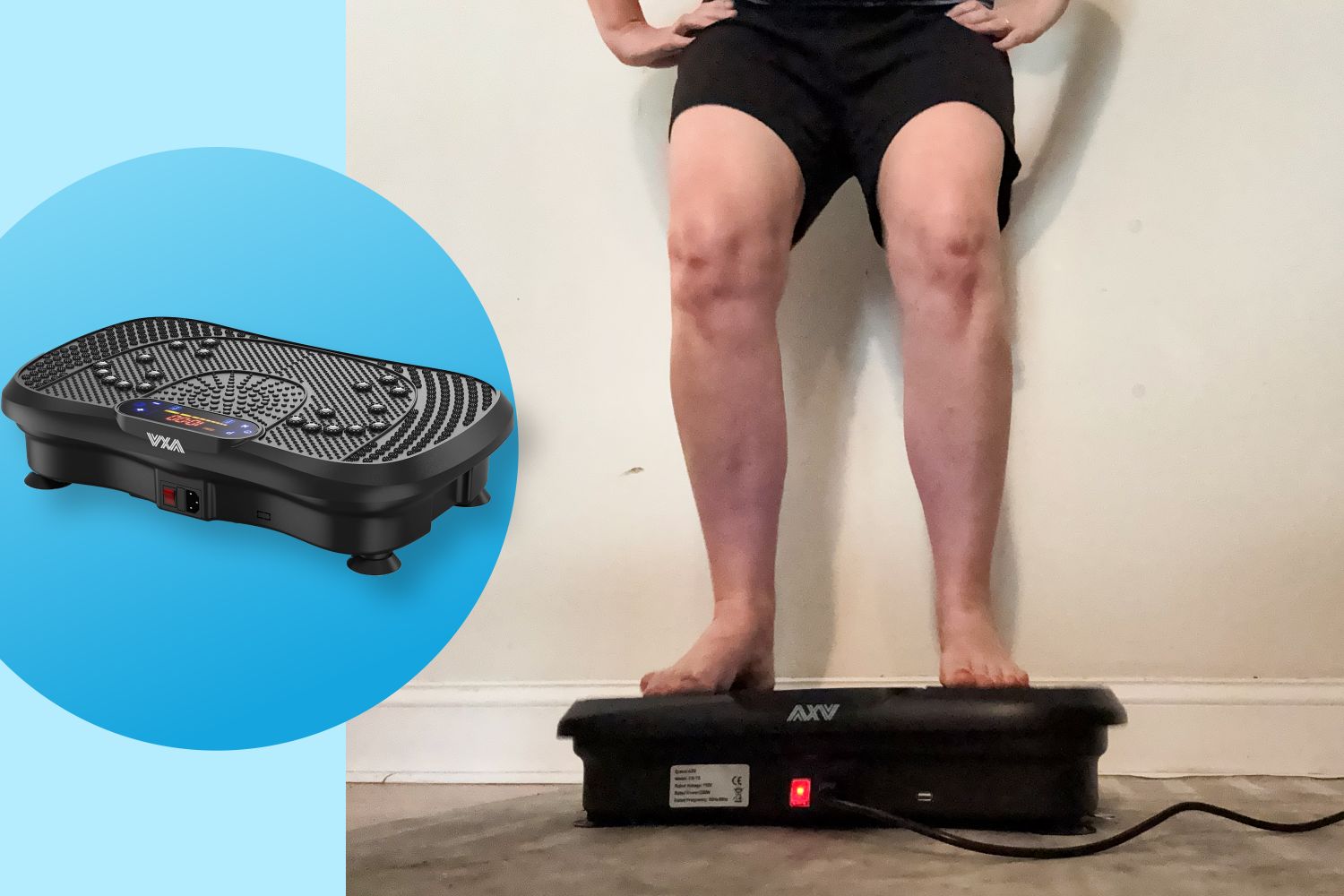It started when I turned 44. A new medication triggered almost instant joint pain in my feet, knees, and ankles. I tried everything my doctor recommended: more exercise (hello, Pilates), stretching, supplements, even extra rest. Nothing worked.
While I was deep in my joint pain spiral, my nightly TikTok habit kept feeding me videos of people raving about vibration plates — you know, those retro-looking machines that shake like the weight-loss belts from the 1960s. I dismissed them as gimmicky, faux science. But eventually, desperation won out.
I began researching and discovered that vibration plates may help reduce inflammation and alleviate joint pain. The science was mixed, but intriguing enough. I figured, what the heck? and ordered the AXV vibration plate, which has strong reviews and is now under $100.
AXV Vibration Plate Review: Does It Work for Joint Pain?
Amazon
How Vibration Plates Work
Often referred to as whole-body vibration machines, these plates generate rapid vibrations that trigger involuntary muscle contractions, often up to dozens of times per second. “When using the plates, the body is required to recruit multiple muscle groups to help stabilize,” Dr. Philip Montana MFD at Maimonides Health tells PEOPLE. “This multi-directional muscle utilization increases local blood flow and promotes lymphatic drainage.”
This neuromuscular stimulation may help enhance circulation, improve balance and coordination, support muscle toning, maintain or improve bone density, and promote lymphatic flow. Results can vary based on the plate’s settings, and the effects on bone density and lymphatic drainage are still being studied.
Note: *These machines are not a replacement for normal exercise and users should contact their doctor before using.
When it arrived, I was skeptical but kind of excited. Setup took five minutes, and I’d watched enough TikToks and consulted Dr. ChatGPT to know I should start slow, just a few minutes a day to let my body adjust.
I stepped on the machine barefoot and immediately burst out laughing as every inch of my 44-year-old body started jiggling. It felt funny, but also surprisingly soothing, like a massage chair. After just a few minutes, I stepped off and the stiffness in my feet and knees was gone. Gone.
People
I thought it might be a fluke, but the next morning, I woke up with noticeably less pain (on a scale of 1 to 10, I would say I was at an 8 and went down to a 3). I used the plate again. Still no pain. That weekend, we traveled, so I skipped it — and by Monday, the joint pain was back in full force. I got home, jumped on the plate, and within minutes, the aching faded again.
I’ve noticed even more benefits over time. Vibration plates are said to aid lymphatic drainage (another buzzy TikTok claim), and I do feel less bloated and puffy. My husband uses it for back pain. My sons, both with some sensory needs, love how it helps them feel regulated and calm.
According to the Experts
I spoke with two experts who both acknowledged the potential benefits, with caveats. Clinton T. Rubin, Ph.D., Director of the Center for Biotechnology at SUNY Stony Brook explained that his team has been studying the risks and benefits of low-intensity vibration and has observed reduced symptoms of chemotherapy-induced peripheral neuropathy, as well as some improvements in neuromuscular health in aging populations.
However, he emphasized that these results were observed using a professional-grade device that delivers Low-Magnitude High-Frequency Vibration (LMHFV) therapy — something many consumer-grade machines, like mine, don’t replicate.
Montana also expressed skepticism about many of the broader claims surrounding vibration therapy, noting that few are backed by robust evidence. However, he pointed out that “what the data does support, consistently, is improved balance and proprioception, particularly in older adults, which can reduce the risk of falls.”
Over the last few weeks, I’ve upped my routine to 10 minutes a day and sometimes I sit on it or try to do squats or planks on it, or if I’m being extra lazy, I sit on my couch with my feet on it while I watch TV. There are some workout routines that are said to be more exercise-focused that I am interested in trying, but I haven’t gotten that far yet.
I’m not making any medical claims, but for me, the AXV vibration plate has made a big difference in how I feel every day. It’s been supplemental to my exercise routine, reduced my stiffness, and brought a little fun into my daily activities.
What to Know Before Buying a Vibration Plate
Start Slow: In my research and combing through comments on TikTok it was noted that some people experienced itchiness, which can happen while this increases your circulation. Start by doing 5 to 10 minutes a day, and you can increase to up to 20 minutes a day over a few weeks.
Look for One with a Remote: The machines with a remote make it a lot easier (and safer) to adjust while you are on it, so look for one with this feature.
Size Matters: The larger the machine, the more exercises you’ll be able to do on it, making it more functional for many needs.
Pricing: You generally get what you pay for. In the $100–$300 range, you’ll find basic oscillating machines with limited settings. Spending $300–$900 typically gets you a wider frequency range and more customizable programs, which may better target specific health and fitness needs. Machines priced at $900 and above usually fall into the professional-grade category, often backed by clinical research and designed for more precise, therapeutic use.
Consult Your Doctor: You should consult your doctor or physical therapist before using, especially if you have balance or aging issues. Some models have a bar you can hold onto, or you can make sure you set this up somewhere that you can hold onto something sturdy for balance.
Lifepro Waver Vibration Plate
Amazon
Lifepro Vibration Plate Machine
Amazon
Eilison Fitmax 3D XL Vibration Plate
Amazon
